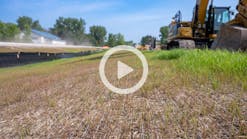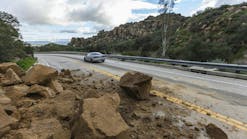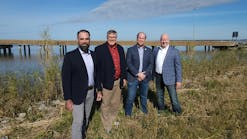The Measurable Parameters Behind Soil Conservation Methods
Before planning and implementing site-specific soil conservation methods, project designers, field specialists, and construction contractors should possess a basic understanding of the soil loss equation and its parameters, which author Linda Robinson explains in “Getting the Upper Hand on Sediment.” Launched as Part 1 (below) in a continuing series, our author explains the sediment control methods and best practices in erosion control from the perspectives of construction project planners and general contractors in the illustrative projects that follow.
Getting the Upper Hand on Sediment (Part 1) by Linda Robinson
Specialized products solve a range of construction site challenges.
We live in a world of acronyms and equations. A world where letters are used for numbers and WOW upside-down is good old MOM. For instance, if the QSP or PE recommends HERO, he may inform the LRP. And that’s just the tip of the iceberg in the world of engineering—whether civil or environmental. It often sounds like teenagers’ secret language.
Getting the Upper Hand on Sediment (Part 1) by Linda Robinson
Specialized products solve a range of construction site challenges. We live in a world of acronyms and equations. A world where letters are used for numbers and WOW upside-down is good old MOM. For instance, if the QSP or PE recommends HERO, he may inform the LRP. And that’s just the tip of the iceberg in the world of engineering—whether civil or environmental. It often sounds like teenagers’ secret language. [text_ad] One crucial acronym for many in the industry is USLE, the universal soil-loss equation—the result of decades of research and data, some of which dates back to the 1920s. Soil specialists have used USLE to establish predicted long-term soil losses. It does not, however, consider losses from gully, wind, or tillage erosion. It predicts patterns of soil loss from sheet or rill erosion on a given slope, but USLE factors can vary widely with weather conditions. Later research led to a revised version, RUSLE. And finally, with the need to handle more complex parameters, that equation was further enhanced to become RUSLE2. The equation as it was developed, says that the soil loss prediction, expressed in metric tons per hectare per year includes: R = rainfall or runoff K = soil erodibility L = slope length S = slope gradient or steepness C = cover and vegetation management P = erosion control practices We may not be able to alter environmental elements like the amount of rainfall a site gets, or its soil structure, but in areas where soil is exposed, we can minimize runoff and the subsequent erosion and sedimentation that follow. Well thought out and precisely placed BMPs can make the difference between soil runoff that can be swept up and runoff that results in deeply carved gullies. Going to the Neighborhood Coffee Shop When Todd Hudson, project manager and estimator for SWIMS (Stormwater Inspection and Maintenance Services Inc.) began work on a Wal-Mart site in Rohnert Park, CA, the first thing he looked at was the catch basins. “There was an existing building being turned into a Wal-Mart neighborhood market,” he explains. “The first thing we did was to install catch basin protection. But at this site they were small, so they had to be modified. We didn’t even need to put gravel bags down.” The Catch Basin Protectors used were a SWIMS product. For perimeter control, Hudson knew he wanted the Heavyweight DuraWattle from WTB Inc. At the site, Wal-Mart was heavily invested in the neighborhood and public relations. The back side of the large industrial site is used as a community short cut, so installing most sediment control products would have resulted in some costly maintenance or replacements. Hudson chose the DuraWattles, because they’re easy to install on the hard asphalt surface and because he did not have to worry about interrupting the flow of traffic. It was an important factor on this job site. “During installation, when the construction fence wasn’t up yet, cars came flying through there,” he laughs. “But they can run right over that DuraWattle, and it just springs right back up. Although the traffic slowed a bit after the signs went up and construction activity got under way, people still used the area as a thoroughfare, especially early in the morning. The neighborhood has a Starbucks back there and a muffin shop. So traffic still drives straight on through.” The Heavyweight DuraWattle was designed as a flexible barrier for use in dewatering and as a sediment barrier. Richard Quinley, owner of WTB Inc., notes that ASTMD 7351 tests show the wattle has 96.6% sediment retention and 58% turbidity reduction. It is also reusable over multiple job sites. “This was particularly good for this project, which had that older asphalt parking lot,” says Hudson. “DuraWattle didn’t have to be glued in place. It’s easy to install with 1- by 4-inch wood planks and concrete anchoring screws every 4 feet. And it’s like a big foam fiber roll; it bounces right back, as opposed to straw, which squishes down and deteriorates.” To date, none of the wattles installed at the site have needed to be replaced.One crucial acronym for many in the industry is USLE, the universal soil-loss equation—the result of decades of research and data, some of which dates back to the 1920s. Soil specialists have used USLE to establish predicted long-term soil losses. It does not, however, consider losses from gully, wind, or tillage erosion. It predicts patterns of soil loss from sheet or rill erosion on a given slope, but USLE factors can vary widely with weather conditions. Later research led to a revised version, RUSLE. And finally, with the need to handle more complex parameters, that equation was further enhanced to become RUSLE2.
The equation as it was developed, says that the soil loss prediction, expressed in metric tons per hectare per year includes:
R = rainfall or runoff
K = soil erodibility
L = slope length
S = slope gradient or steepness
C = cover and vegetation management
P = erosion control practices
We may not be able to alter environmental elements like the amount of rainfall a site gets, or its soil structure, but in areas where soil is exposed, we can minimize runoff and the subsequent erosion and sedimentation that follow. Well thought out and precisely placed BMPs can make the difference between soil runoff that can be swept up and runoff that results in deeply carved gullies.
Going to the Neighborhood Coffee Shop
When Todd Hudson, project manager and estimator for SWIMS (Stormwater Inspection and Maintenance Services Inc.) began work on a Wal-Mart site in Rohnert Park, CA, the first thing he looked at was the catch basins.
“There was an existing building being turned into a Wal-Mart neighborhood market,” he explains. “The first thing we did was to install catch basin protection. But at this site they were small, so they had to be modified. We didn’t even need to put gravel bags down.”
The Catch Basin Protectors used were a SWIMS product. For perimeter control, Hudson knew he wanted the Heavyweight DuraWattle from WTB Inc.
At the site, Wal-Mart was heavily invested in the neighborhood and public relations. The back side of the large industrial site is used as a community short cut, so installing most sediment control products would have resulted in some costly maintenance or replacements. Hudson chose the DuraWattles, because they’re easy to install on the hard asphalt surface and because he did not have to worry about interrupting the flow of traffic. It was an important factor on this job site.
“During installation, when the construction fence wasn’t up yet, cars came flying through there,” he laughs. “But they can run right over that DuraWattle, and it just springs right back up. Although the traffic slowed a bit after the signs went up and construction activity got under way, people still used the area as a thoroughfare, especially early in the morning. The neighborhood has a Starbucks back there and a muffin shop. So traffic still drives straight on through.”
The Heavyweight DuraWattle was designed as a flexible barrier for use in dewatering and as a sediment barrier. Richard Quinley, owner of WTB Inc., notes that ASTMD 7351 tests show the wattle has 96.6% sediment retention and 58% turbidity reduction. It is also reusable over multiple job sites.
“This was particularly good for this project, which had that older asphalt parking lot,” says Hudson. “DuraWattle didn’t have to be glued in place. It’s easy to install with 1- by 4-inch wood planks and concrete anchoring screws every 4 feet. And it’s like a big foam fiber roll; it bounces right back, as opposed to straw, which squishes down and deteriorates.” To date, none of the wattles installed at the site have needed to be replaced.






